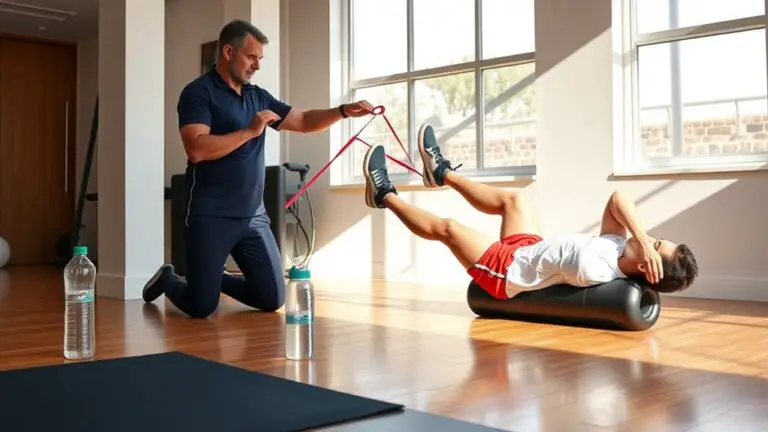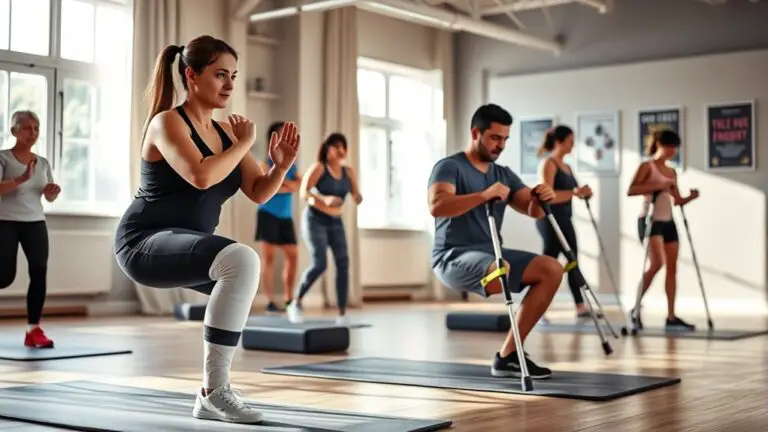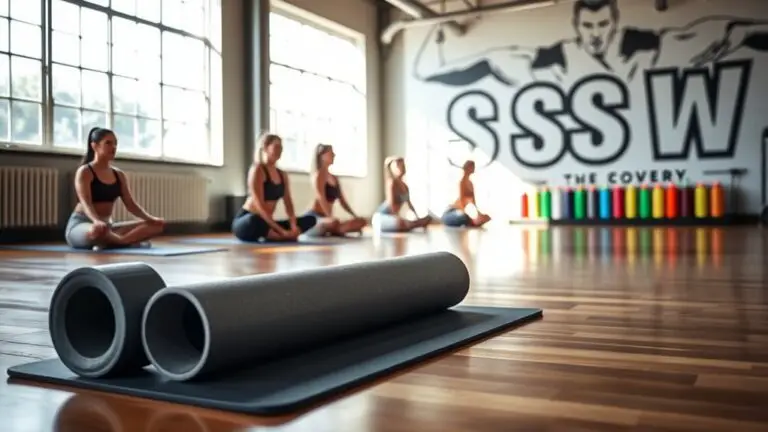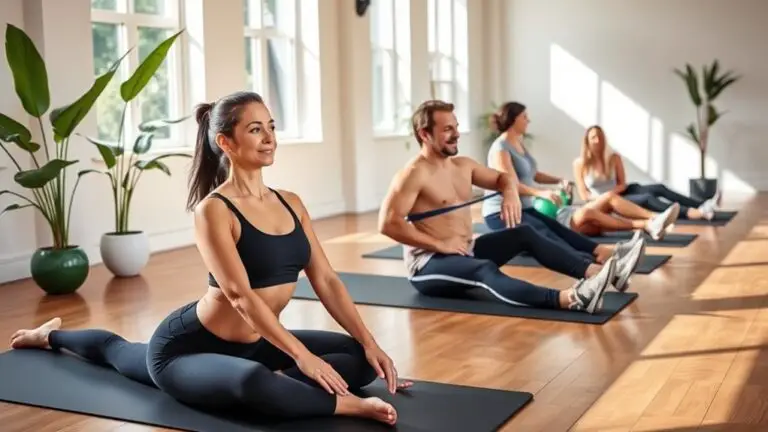The Best Post-Workout Stretches to Avoid Injuries

To avoid injuries post-workout, prioritize key stretches like the hamstring, quadriceps, chest, shoulder, hip flexor, lower back, and calf stretches. Holding each stretch for 15 to 30 seconds helps improve flexibility and promotes recovery. Remember to breathe deeply and maintain proper form to maximize benefits. Incorporating these stretches into your routine enhances circulation and supports muscle relaxation. Want to learn more about effective stretching techniques and routines? There’s plenty more to explore!
The Importance of Stretching After Workouts
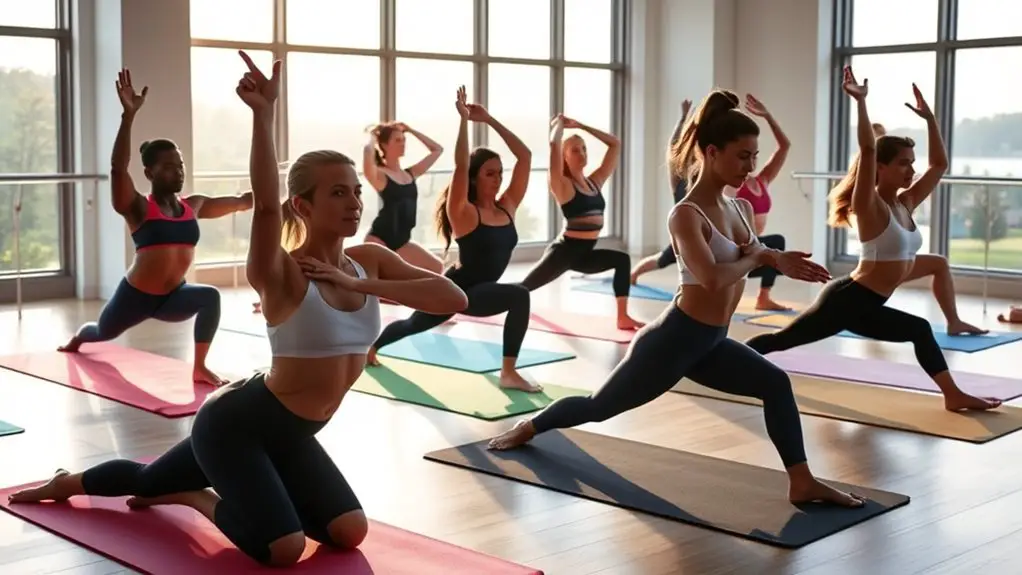
While you might feel tempted to skip stretching after a workout, doing so can greatly impact your recovery and overall performance. Stretching helps to enhance flexibility, improve circulation, and reduce muscle soreness, which are essential for ideal recovery. By incorporating post-workout stretches, you’re allowing your muscles to relax and return to their normal length, promoting better mobility.
However, many people make common stretching mistakes, such as bouncing during stretches or holding them for too short a time. These errors can lead to injuries rather than benefits. Instead, focus on holding each stretch for 15-30 seconds and breathing deeply to maximize effectiveness. It’s also important to remember that stretching post-workout is generally recommended for warm muscles, as cold muscles are more resistant to stretching, increasing injury risk.
Prioritizing these post-workout stretches not only prevents tightness but also prepares your body for future workouts. Make stretching a regular part of your routine to reap its full benefits and support your fitness goals.
Hamstring Stretch
Incorporating specific stretches into your post-workout routine can greatly enhance recovery, and the hamstring stretch is a key component. Tight hamstrings can lead to discomfort and increase the risk of hamstring injuries, so it’s essential to prioritize this stretch. After your workout, take a moment to perform a static hamstring stretch by sitting on the floor with one leg extended and the other bent. Reach toward your toes, holding the position for 15-30 seconds.
You may also consider dynamic stretching before workouts to warm up your hamstrings effectively. Examples include leg swings and walking lunges, which prepare your muscles and reduce injury risk. Remember, stretching after exercise helps improve flexibility, promotes blood flow, and aids in muscle recovery. By consistently incorporating the hamstring stretch into your routine, you can greatly lower the chances of injury and enhance overall performance.
Quadriceps Stretch

The quadriceps stretch is essential for maintaining flexibility and preventing injuries in the front of your thighs. After a workout, it’s important to include both dynamic quadriceps and static quadriceps stretches in your routine. Dynamic quadriceps stretches, like walking lunges or high knees, help prepare your muscles for activity while improving range of motion.
On the other hand, static quadriceps stretches, such as the standing quad stretch, are crucial for cooling down and promoting recovery. To perform a standing quad stretch, simply stand on one leg, bend the opposite knee, and grab your ankle to pull your heel toward your glutes. Hold this position for 15-30 seconds, feeling the stretch along the front of your thigh.
Incorporating these stretches will not only enhance your flexibility but also reduce the risk of strains and injuries, ensuring you stay active and pain-free.
Chest Stretch
To enhance your upper body flexibility and promote recovery after a workout, a chest stretch is essential. This chest opener not only alleviates tightness but also improves your posture and range of motion. Incorporating this stretch into your routine can help prevent injuries and facilitate muscle recovery, especially for those who engage in activities like skipping rope that involve repetitive upper body movement.
To perform a chest stretch effectively, follow these steps:
- Stand tall with your feet shoulder-width apart.
- Clasp your hands behind your back, palms together.
- Gently pull your shoulders back and lift your arms slightly.
- Hold the position for 15-30 seconds, breathing deeply.
Shoulder Stretch

While you might feel the strain in your shoulders after an intense workout, a proper shoulder stretch can greatly relieve tension and enhance mobility. Incorporating shoulder stretches into your post-workout routine is essential for preventing injuries and improving overall performance.
To perform a basic shoulder stretch, reach one arm across your body, holding it with your opposite arm just above the elbow. Gently pull the arm towards your chest, feeling the stretch across the shoulder. Hold this position for 15 to 30 seconds, then switch sides.
Another effective option is the overhead stretch. Raise both arms above your head, interlock your fingers, and gently lean to one side, then the other. This not only helps reduce shoulder tension but also promotes shoulder mobility. Consistent stretching post-workout keeps your shoulders flexible and helps you recover faster, ensuring you’re ready for your next session.
Hip Flexor Stretch
Incorporating hip flexor stretches into your post-workout routine is essential for maintaining lower body flexibility and preventing tightness after intense exercise. Neglecting these stretches can lead to discomfort and even injuries. Understanding the hip flexor benefits can enhance your overall performance and recovery.
Here are some effective hip flexor techniques to take into account:
- Kneeling Hip Flexor Stretch: Get into a lunge position, keeping your back knee on the ground, and push your hips forward to feel the stretch.
- Pigeon Pose: Sit on the floor and bring one leg forward while extending the other leg back, allowing for deeper hip opening.
- Standing Quad Stretch: Stand on one leg, grabbing the opposite ankle and pulling it towards your glutes to stretch the hip flexor.
- Butterfly Stretch: Sit with the soles of your feet together, gently pressing your knees down to open the hips.
Incorporate these techniques for ideal flexibility and injury prevention.
Lower Back Stretch

Lower back stretches play an essential role in alleviating tension and enhancing flexibility after a workout. When you engage in physical activity, your lower back may become tight, leading to discomfort or even lower back pain. Incorporating specific stretches can help counteract this tension and improve spine flexibility.
One effective stretch involves lying on your back with your knees bent and feet flat on the floor. Gently pull your knees toward your chest, holding for 20-30 seconds. This stretch targets the lower back and helps release built-up tension. Another option is the seated forward bend, where you sit with your legs extended and reach for your toes, promoting flexibility in the lower back while also stretching the hamstrings.
Incorporating these stretches into your post-workout routine can notably reduce the risk of lower back pain and enhance overall mobility, ensuring you stay active and injury-free.
Calf Stretch
After addressing lower back tension, it’s important to focus on your calves, which can also tighten during workouts. Stretching your calf muscles will enhance flexibility and prevent injuries. Here are some effective stretching techniques you can incorporate:
- Standing Calf Stretch: Stand facing a wall, place your hands on it, step back with one leg, and press the heel down.
- Seated Calf Stretch: Sit on the floor with one leg extended, loop a towel around your foot, and gently pull toward you.
- Downward Dog Stretch: From a plank position, lift your hips up and back, pressing your heels towards the ground.
- Calf Raises: While standing, rise onto your toes and lower back down to engage and stretch the calves.
Incorporating these stretches will guarantee your calf muscles recover properly, enhancing your overall performance and reducing the risk of injury. Jumping rope also effectively improves coordination and balance, which can contribute to better calf flexibility.
Full-Body Stretch Routine

A well-rounded full-body stretch routine can greatly enhance your recovery and flexibility after a workout. Incorporating dynamic stretching into your cooldown can help maintain muscle elasticity and prepare your body for future exertion. Start with gentle neck rolls and shoulder shrugs to relieve tension. Shift into arm circles and torso twists to engage your upper body fully.
For your lower body, perform hip openers and lunges, ensuring you stretch your quadriceps and hamstrings effectively. Don’t forget to include seated stretches like the butterfly stretch to target your inner thighs and groin.
These stretches not only promote flexibility benefits but also reduce the risk of injury by improving your range of motion. Aim to hold each stretch for 15 to 30 seconds, breathing deeply to encourage relaxation. By committing to this full-body stretch routine, you’ll support your body’s recovery and enhance your overall performance.
Frequently Asked Questions
How Long Should I Hold Each Stretch?
When considering how long you should hold each stretch, aim for a duration of 15 to 30 seconds. This stretch duration is generally effective for enhancing flexibility and promoting muscle recovery. By holding each stretch for this time frame, you’re maximizing stretch effectiveness without overexerting your muscles. Remember to breathe deeply during each stretch, as this can further enhance relaxation and improve your overall stretching experience.
Can I Stretch on Non-Workout Days?
Just as a river flows, so should your approach to fitness. Yes, you can absolutely stretch on non-workout days. Engaging in stretching during these days acts as active recovery, promoting blood circulation and muscle relaxation. You’ll also reap the flexibility benefits, enhancing your range of motion and preventing stiffness. Incorporating gentle stretches into your routine can keep your body limber and ready for your next workout, making it a smart choice for overall wellness.
Should I Warm up Before Stretching?
Yes, you should definitely warm up before stretching. Dynamic stretching, which involves moving parts of your body through their full range of motion, prepares your muscles and joints for activity. This not only enhances flexibility but also contributes to injury prevention. By increasing blood flow and warming up your body, you’ll be better equipped to perform static stretches effectively and safely, reducing the risk of strains or sprains during your workout.
What if I Feel Pain While Stretching?
Did you know that nearly 30% of people experience discomfort while stretching? If you feel pain during stretching, it’s vital to listen to your body. Pain management is essential; you shouldn’t push through sharp or intense discomfort. Instead, focus on gentle stretching techniques and modify your approach. Consider consulting a professional to assess your form and identify any underlying issues. Remember, stretching should feel good, not painful.
Are There Stretches to Avoid After Workouts?
After workouts, it’s essential to choose your stretches wisely. You should avoid dynamic stretching, as it’s designed for warming up muscles before exercise, not for post-workout recovery. Instead, focus on static stretching, which helps lengthen muscles and promotes flexibility. Holding stretches for 15-30 seconds can aid in muscle relaxation and recovery. Always listen to your body; if something feels painful, it’s best to skip that particular stretch.

